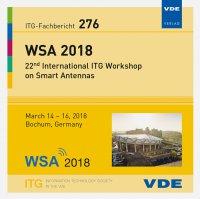NOCA versus IDMA using UFMC for 5G Multiple Access
Konferenz: WSA 2018 - 22nd International ITG Workshop on Smart Antennas
14.03.2018 - 16.03.2018 in Bochum, Deutschland
Tagungsband: WSA 2018
Seiten: 5Sprache: EnglischTyp: PDF
Persönliche VDE-Mitglieder erhalten auf diesen Artikel 10% Rabatt
Autoren:
Attar, Mohammadhossein (Communications Reserach Laboratory, Ilmenau University of Technology, 98684 Ilmenau, Germany & Nokia Bell Labs, Lorenzstr. 10, 70435 Stuttgart, Germany)
Chen, Yejian; Cheema, Sher Ali; Haardt, Martin (Communications Reserach Laboratory, Ilmenau University of Technology, 98684 Ilmenau, Germany)
Wild, Thorsten (Nokia Bell Labs, Lorenzstr. 10, 70435 Stuttgart, Germany)
Inhalt:
Non-orthogonal multiple access (NOMA) schemes are gaining a lot of attentions for fifth generation (5G) cellular networks. As compared to the conventional orthogonal multiple access technologies, NOMA techniques can accommodate much more users via non-orthogonal resource allocation. Existing dominant NOMA schemes can be divided into two main categories: power-domain multiplexing and code-domain multiplexing. In this work, we evaluate the performance of two code-domain multiplexing techniques: interleave-division multiple access (IDMA) and non-orthogonal coded access (NOCA). We propose different detection schemes for these access schemes. Specifically, we integrate these techniques with one of the 5G air interface proposals, i.e., universal filtered multicarrier (UFMC). We compare the performance of these multiple access schemes with cyclic prefix orthogonal frequency division multiplexing (CP-OFDM) based IDMA and NOCA techniques. Our results indicate that a large number of users can be accommodated with these techniques. Moreover, using UFMC or CP-OFDM in conjunction with these code-domain multiplexing techniques provides a similar performance in a synchronous environment.


